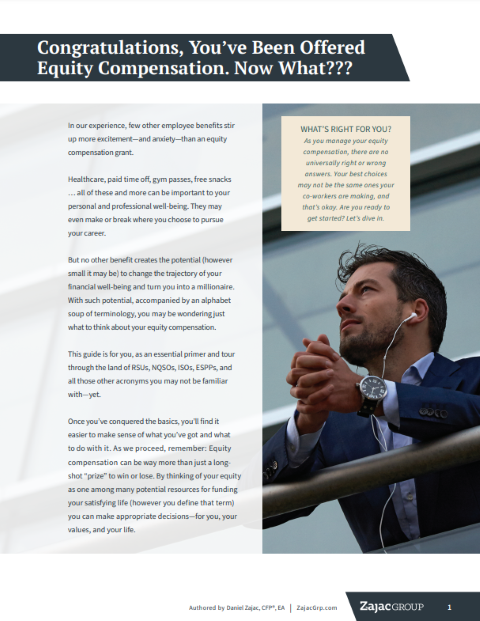Incentive stock options (ISOs) are a form of compensation distributed by a company to their employees. Typically, companies use incentive stock options as a vehicle to retain top employees, reward specific milestones or successes or as an incentive when hiring new employees.
ISOs can be a lucrative long-term compensation benefit, particularly if you work for a company that is growing quickly and has a rising stock price. Because they may be highly valuable, incentive stock options have several components that are worth studying.
1 – What is an Incentive Stock Option?
An incentive stock option is a specific type of employee stock option that allows you the right to purchase shares of stock at a predetermined price at some point in the future. You are given – or “granted” – a certain number of incentive stock options allowing you to purchase that number of shares of stock.
When you purchase company stock shares via your option, the process is known as exercising your incentive stock options. There are several aspects to exercising your options, as you’ll see below.
2 – How Do You Receive Incentive Stock Options?
You are awarded incentive stock options from your company in the form of an option grant. Usually you’ll be required to “accept” the option grant before it becomes official by signing an acceptance form. This is a formality.
When you receive an incentive stock option grant from your company, it will include several elements that will impact what you can do with your options and when. This information will likely be provided in a combination of documents including the plan document, the plan prospectus, and your specific stock grant details. It may be wise to obtain this information from your HR department, as company plan rules can differ.
FREE GUIDE
The Ultimate Guide to Incentive Stock Options
Learn the ins and outs of incentive stock options so you gain a better understanding of what you have.
3 – What is Included in an Incentive Stock Option Grant?
Your ISO grant will include the number of share options you are being granted. This is equal to the number of shares you can exercise and buy.
The ISO grant will also include a share price, called the “strike” price or “exercise” price, which is often set by the stock price on the day the company completes the option paperwork. The exercise price determines how much you will pay for each incentive stock option. This price, multiplied by the number of granted options will tell you how much it will cost you to exercise all your options.
Your ISOs will also include a grant date. This is important because it may affect both when you can exercise your options and the tax implications, which we’ll cover shortly.
The option grant will also include a vesting schedule. The vesting schedule is the timeframe that dictates when you can exercise your stock options.
For example, a 5-year schedule might vest 20% of the ISOs per year until fully vested. Often, vesting schedules are designed to reward you for staying with the company for longer periods of time and can be used as a retention tool for valued employees. Should you leave the company before your ISOs vest, the options may be subject a forfeiture provision where the company will take back unvested options upon your departure.
4 – What is the Process for Exercising Your Incentive Stock Options?
You can exercise ISOs in one of several ways. The approach you choose will depend on your short- and long-term financial goals, cash position, tax situation, need for immediate income, among others. This is an important decision and often worth consulting an investment professional to determine the best approach for your situation.
First, after some or all of your incentive stock options have vested, you can pay cash up front to purchase them. For example, if you were granted 1000 options at an exercise price of $10 per share, once vested, you could purchase the 1000 shares of stock for $10,000 (1000 x $10 = $10,000.) While this is a large sum of cash, purchasing the shares up front can be advantageous if you plan to hold the shares for a long period of time to take advantage of certain tax benefits and hoped-for stock price increases.
You can also exercise your ISOs through a cashless transaction where you immediately sell your vested shares as soon as they are exercised, using the profits to pay for the option costs, and potential taxes, keeping the remainder.
A third approach is to sell enough of the ISOs to pay for the cost of exercising the options, converting the remaining ISOs into shares of stock and holding the stock until a future date. Assuming the company stock has increased in value since your incentive stock options were awarded, you can sell a portion and take the profits to pay for the remaining shares.
For example, by selling 100 shares @ $100 each, you will receive $10,000, enough funds to pay for all 1000 shares. After selling the 100 shares, you will own the 900 remaining shares.
5 – When Should I Exercise My Incentive Stock Options?
There are a number of factors that affect when you should exercise your ISOs. Again, this is a topic where a financial expert can be invaluable.
Of course, you’ll only be eligible to exercise your ISOs once they have vested. Fortunately, you are allowed to exercise the options as soon as they vest, in most circumstances.
In our earlier example, where 1000 ISOs vested 20% per year over five years, after year one, you would be eligible to exercise 200 ISOs (1000 x 20% = 200).
If the company’s stock has gone up since you were granted the ISO, it may make good sense to exercise the vested options, selling the shares in a cashless transaction and reaping the profits. Some factors that come into play in this decision include whether you need the funds in the near term, whether you’re concerned for the long-term health of the economy, general stock market trends, future prospects of the company, among others.
However, if you have confidence the company will continue to grow and the share price will continue to go up, you can consider waiting for a period of time before exercising your vested options.
Here’s a special circumstance to keep in mind. If you are deemed a company insider, that is, an executive with knowledge of the company’s strategic plans or potential future earnings, you may only be able to exercise options (or sell common stock) during what’s called a trading window, typically in the middle of a given fiscal quarter. If you know you are an insider or you think you may be, you may want to consult your legal department before you do anything with your options. This helps protect other shareholders who invest in the company but do not have access to the same level of information as company insiders.
6 – Should I Exercise My ISOs As Soon As They Vest, Or Wait?
When to exercise your ISOs is a judgment call based on a number of factors. First, do you have strong confidence that the company will continue to grow its revenues and, thus, its share price? Remember that often there are macroeconomic factors outside the company’s control that impact whether a company’s stock increases or decreases in value. Trying to predict the future always comes with risk.
Do you need the money now? Are there debts, college funds, a home down payment or other compelling factors that require immediate access to the funds? If so, exercising the ISOs and taking the associated profits can make good financial sense.
If your ISOs and perhaps employee stock purchases represent the lion’s share of your investment portfolio, diversifying your money by exercising your options and moving the profits to other investment vehicles may help protect your long-term financial prospects.
7 – What are the Tax Implications of Incentive Stock Options?
When exercising ISOs, there are two primary possible tax treatments, called qualifying distributions and disqualifying distributions.
Qualifying distributions may help minimize your tax liability. Qualifying distributions apply when the final sale of the stock occurs at least two years after the option grant date and at least a year after the exercise date.
As a result, your entire profit from the transaction is taxed at long-term capital gains rates, 0%, 15% or 20%, rather than as ordinary income, likely a higher rate. (Higher-income earners may also owe the 3.8% Medicare surtax on the net investment income.)
Disqualifying distributions occur when you exercise your options in any other way that does not meet the standard for qualifying disposition. One potential benefit of this approach is you have access to the funds from the stocks you sell. This helps protect you against a possible drop in the stock price while waiting to sell and you’ll know how much profit to expect from the transaction.
When you exercise your ISOs, the profit, or spread, is treated as income for alternative minimum tax (AMT) purposes. This could trigger having to paying the AMT in that tax year.
It’s helpful to be familiar with the various tax forms that are commonly associated with incentive stock options. For example, ISOs are reported on Form 1040. You may have ordinary income, capital gains (or losses), or both, which will be reported on your 1040 tax return.
Your Form W-2 will include any compensation income received from your employer shown on your W-2, including your income from ISOs upon selling your stock.
You will receive a Form 1099-B the year you sell your ISO stock shares. It reports capital gain or loss on your tax return.
Your employers will also provide a Form 3921 (Exercise of Incentive Stock Options) for the year you exercise ISOs. Information on the form will help you determine AMT, if applicable.
In the event you are required to pay the Alternative Minimum Tax from profits from selling ISO shares , you will need to file Form 6251 (Alternative Minimum Tax), which you use to report AMT from the exercise of incentive stock options.
If you have a financial advisor or tax accountant, they will be very familiar with these forms and can help you properly prepare your filings.
Moving Forward with Your Incentive Stock Options
Incentive stock options are a powerful tool that may help create great wealth. The more successful the company is, the more options you have, and the lower the exercise price, the more you may stand to gain as the company’s stock price climbs.
They are also potentially complicated compensation vehicles that integrate advanced tax, investment, and personal financial planning goals. This is why it often takes a specialist in equity compensation or, more likely, a team of individuals to help plan for a suitable outcome.
This leads to the fact that there are a number of important decisions to consider when developing your financial strategy around your ISOs. It’s important to find an expert to help guide you, saving you money, time and possible tax liabilities down the road.










0 Comments